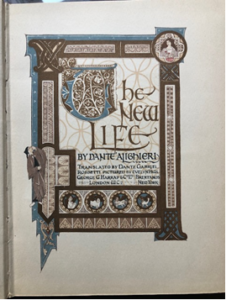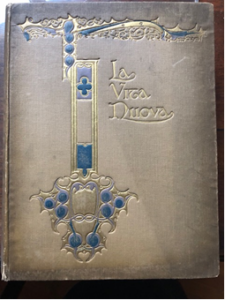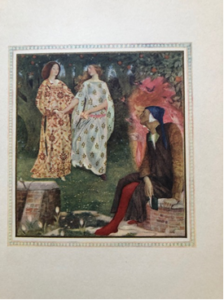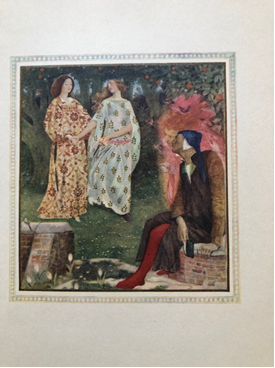Vita Nuova, Dante Alighieri and Dante Gabriel Rossetti’s translation
Prof. Francesco Carelli



translated by Dante Gabriel Rossetti
pictured by Evelyn Paul
with music by Alfred Mercer
Author’s ownership
La Vita Nuova, Italian for “The New Life” or Vita Nova, Latin title, is a text by Dante Alighieri published in 1294. It is an expression of the medieval genre of courtly love in a prosimetrum style, a combination of both prose and verse.
Referred to by Dante as his libello, or “little book,” La Vita Nuova is the first of two collections of verse written by Dante in his life. The collection is a prosimetrum, a piece containing both verse and prose, in the vein of Boethius’ Consolation of Philosophy. Dante used each prosimetrum as a means for combining poems written over periods of roughly ten years—La Vita Nuova contains his works from before 1283 to roughly 1293. The collection and its style fit in with the movement called dolce stil novo.
The prose creates the illusion of narrative continuity between the poems; it is Dante’s way of reconstructing himself and his art in terms of his evolving sense of the limitations of courtly love, the system of ritualized love and art that Dante and his poet-friends inherited from the Provençal poets, the Sicilian poets of the court of Frederick II, and the Tuscan poets before them. Sometime in his twenties, Dante decided to try to write love poetry that was less centered on the self and more aimed at love itself. He intended to elevate courtly love poetry, many of its tropes and its language, into sacred love poetry. Beatrice for Dante was the embodiment of this kind of love, transparent to the Absolute, inspiring the integration of desire aroused by beauty with the longing of the soul for divine splendor, as so well written in Divina Commedia.
The most interesting the translation into English was written by Dante Gabriel Rossetti, the famous pre-Raphaelite painter and writer, with miniate pictures by Edith Pau.
La Vita Nuova contains 42 brief chapters, with commentaries on 25 sonnets, one ballata, and four canzoni; one canzone is left unfinished, interrupted by the death of Beatrice Portinari, Dante’s lifelong love.
Dante’s two-part commentaries explain each poem, placing them within the context of his life. The chapters containing poems consist of three parts: the semi-autobiographical narrative, the lyric that resulted from those circumstances, and brief structural outline of the lyric. The poems present a frame story, recounting Dante’s love of Beatrice from his first sight of her (when both were nine years old) all the way to his mourning after her death, and his determination to write of her “that which has never been written of any woman.” Each separate section of commentary further refines Dante’s concept of romantic love as the initial step in a spiritual development that results in the capacity for divine love. Dante’s unusual approach to his piece — drawing upon personal events and experience, addressing the readers, and writing in Italian rather than Latin — marked a turning point in European poetry, when many writers abandoned highly stylized forms of writing for a simpler style.
Dante wanted to collect and publish the lyrics dealing with his love for Beatrice, explaining the autobiographical context of its composition and pointing out the expository structure of each lyric as an aid to careful reading. The result is an important early example of emotional autobiography, as was Saint Augustine’s Confessions in the 5th century. However, like all medieval literature, it is far removed from the modern autobiographical impulse. Dante and his audience were also interested in the emotions of courtly love and how they develop, how they are expressed in verse, how they reveal the permanent intellectual truths of the divinely created world and how love can confer blessing on the soul and bring it closer to God.





